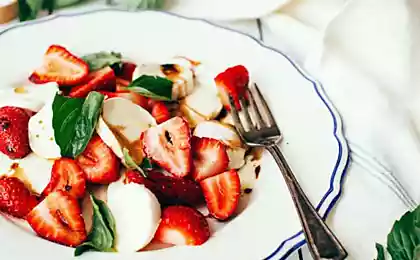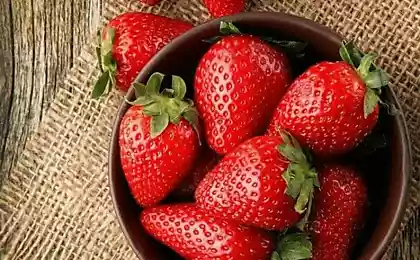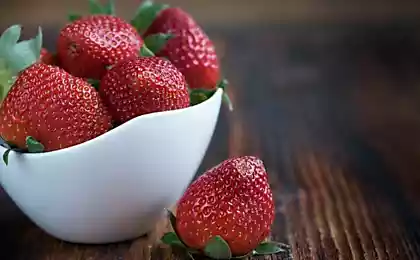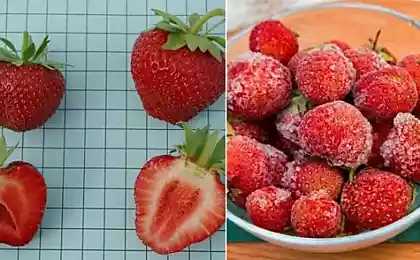577
Growing strawberries in bags

Growing strawberries in bags not much different from the cultivation of these beautiful berries in the other tanks, but there are some subtleties here.
In the winter I specifically chose the 5 best varieties of strawberries in the catalogue and ordered by mail from the nursery. Read more about these new varieties I'm going to write soon. Buy bags for growing strawberries I failed, had to use the exact same bags for growing tomatoes. Bags for tomatoes, filled with soil already mixed with fertilizer, perfect for growing strawberries. And tomatoes and strawberries are fruits, that is, require high amounts of potassium fertilizer for good fruit production. Ready for growing bags already have small holes for water drainage.
Bags for growing strawberries I put on flat walls that enclose our patio from the flower bed. These walls are in the sun most of the day and therefore perfect for growing strawberries. In bags on the surface I did a hole with the scissors cross (you can make rectangular slot). In the technology of growing strawberries in bags, which I saw in the Botanical gardens in each bag put 3-4 strawberries Bush. I thought that I for a start it is possible to plant more bushes in each bag and made the slits in a staggered manner. However, later I noticed that the bushes tall strawberry throw at each other quite a lot of shade (see photo), so probably still better to plant the strawberries in the bags are a bit less than I did. 8 bushes on the bag is optimal.
Strawberries in bags — postepisode by mail planting material of strawberry with open root system I soaked for an hour in water, as recommended. Bags for growing strawberries need a little shake to the ground inside was a little more loose. When landing a bit harder than I expected, was the location of the huge root system of the strawberry plants in the bag. The fact is that growing strawberries in containers before, I always dealt with the planting of the garden centres in small pots, or with plants grown from ‘moustache’ my strawberries. The roots of such planting material is much less than that, which is grown for sale with open root system (see photo). Had a bit of hard time, shoving the roots of the strawberry in small slits in the bags. Despite the presence of potash in the soil bag, I added a full slow-acting fertilizer when planting under every Bush of strawberries. When planting strawberries in bags, as well as in the open ground, it is necessary to ensure that the growth point was flush with the soil level. If the strawberries will be planted above, then the roots will dry out, if below — the plant may rot.
The strawberries in the bags I put at the end of February (could be sooner, our climate allows), and in early March, she took root and began to grow and develop. In early may bloom the first strawberries, and now, at the end of may when I write this article, we have already collected the first harvest of early strawberry varieties Cristina grown in bags (see photo).
Growing strawberries in bags — technologies General, the technology of growing strawberries in bags is the same as in the cultivation of strawberries the more traditional methods.
For irrigation of strawberries in the bags I personally use a regular hose, which is sent directly into the hole in the bag. Besides, I grow strawberries in bags on the street, i.e. irrigation is provided and the most natural method — the rain. If you have a lot of bags with strawberries, you can create a more advanced system of irrigation, see photos of strawberries in bags of the Botanical garden. If the weather is too rainy, you can cover the bags with strawberries whole film. Film cover will protect the berries from the water and rotting.
When ripe berries mulching of space around the strawberries with straw or garden fabric to protect fruit is not required, the function of mulch is a plastic bag. Don't forget that if strawberries are in the bag located high enough from the ground, it will be subject to invasion by slugs and snails, though less than what is grown in the beds. After flowering and the formation of the first berries should be added to the care of strawberries in bags of weekly liquid feeding, because the trace elements in the soil has been mainly used. For fertilizing strawberries to use compositions with a high content of potassium, for example, fertilizer for tomatoes or fruit trees. Very efficient watering with a solution of chicken manure .
After fruiting and harvest the old leaves of strawberries in bags is cut to a height of approx. 10 cm from the ground, as normal, to give the rosette plants and the young leaves access to light — it will make stronger plants for next year. ‘Mustache’ strawberries can be rooted in small pots, setting them next to the bags.Strawberry seedlings from their own ‘moustache’ are planted in the bags in August so she has time to take root for the rest of the summer and autumn. Planting material from the nursery with exposed root system can be planted in the bags at any time, but should again be done as early in spring as soon as weather permits. Good to combine in the bag strawberries the different timing of fruiting, then to collect the harvest will be longer. For earlier harvest, you can put bags of strawberries in the greenhouse or cover with garden fleece in the early spring.
Autumn, to fill up land in the holes with the strawberry plants, if the roots are bare. In cold regions in winter, remove the bags with strawberries in a cool place (cellar, pricop, etc.) and store with minimal watering (it is only necessary that the soil does not dry completely). If you live in a cold region and leave the bags in the winter in the garden, they should cover more securely than the strawberries in the open ground.
In the second year of growing begin fertilizing strawberries in bags for it from the start of the growing season because the soil in the bag is depleted. The strawberries grown in bags not more than 2 seasons of fruiting, then the old plants thrown away, taking from them the right amount of ‘mustache’ and the soil from the bag scattered in the garden.
Source: countrysideliving.net/























